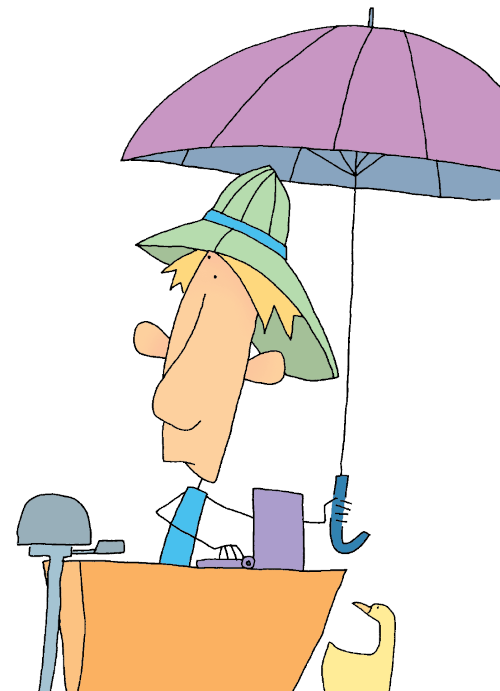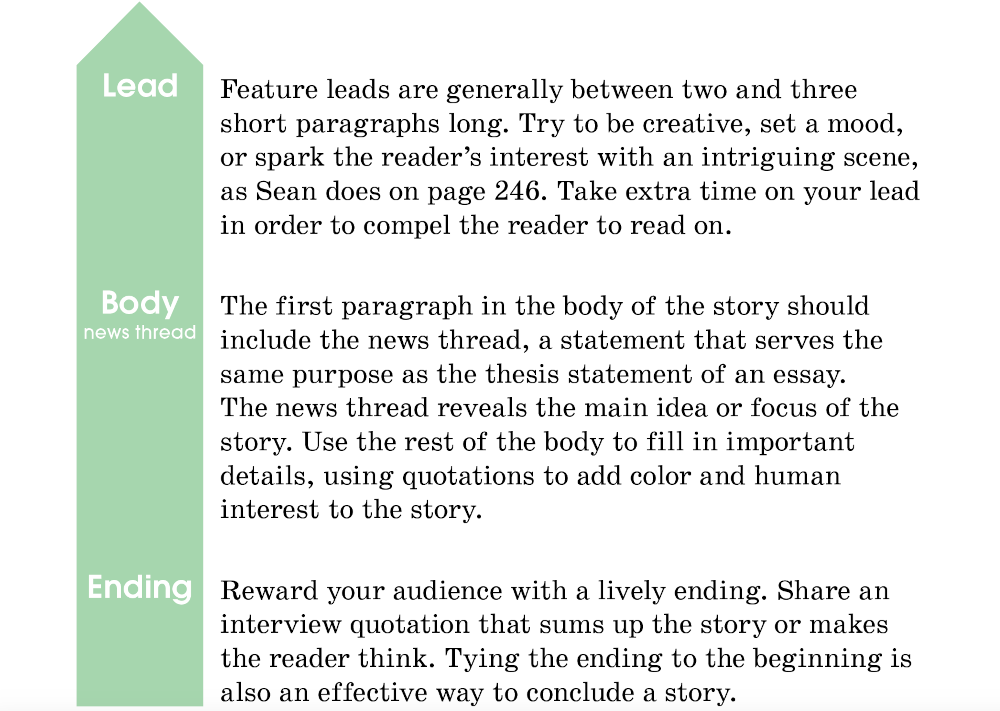WOC 244
Page 244
WOC 245
Page 245
Writing Feature Stories

Feature stories focus on creating a human connection to a person, place, thing, or event. They go beyond the simple 5 W’s of who, what, where, when, and why to answer what’s so cool about this? A feature story helps readers experience something wonderful themselves.
To write an effective feature story, you also need to experience it. Go to the place, talk to the people involved, fill your mind with sights, sounds, smells, and tactile information. For example, the student writer of the model in this chapter attended the SeaPerch Fun Challenge miniature submarine competition at the Navy research pool on Point Loma. His feature is filled with details that make you feel like you’re in a boat floating on the pool as submersibles race around below you. Immerse readers in your feature!
What’s Ahead
WOC 246
Page 246
Feature Story
In the following feature story, student journalist Sean Anderson hooks the reader by setting up a dramatic scenario. This story appeared in the education section of his community newspaper.
Little Poseidon Takes on the World!

Beginning
The writer leads with a dramatic scenario. Team Poseidon stared down intently into the pool as their miniature submarine navigated toward the narrowest gate. They’d seen other middle school teams snag themselves in the netting instead of sliding through to the fourth quadrant.
Little Poseidon, as the robotic submarine was dubbed, paused, reversed course, pivoted, and slid through. A cheer erupted from the team and the Navy judges. Team Poseidon was moving to the big pool!
Middle
The news thread, or thesis, (underlined) gives the story focus. Such cheers rang out repeatedly at the SeaPerch Fun Challenge in the Navy’s research center on Point Loma. The competition brings teams from 30 middle and high schools worldwide to test their remote-control submersibles in challenging underwater mazes.
“There’s kids here from Egypt and India and Japan!” said Sara Wilcox, seventh-grade captain of Team Poseidon from Washington Middle School. “It’s cool to race our sub against the best in the world!”
For more than two decades, the SeaPerch Fun Challenge has inspired the next generation of engineers, programmers, and builders. Crowds of spectators line the big pool and watch the underwater action on a large-screen display.
Little Poseidon launched in the big pool and ran the gauntlet of gates. Small and nimble, the submarine glided through the maze to finish with a qualifying time. The team reached the quarter-finals, the only middle-school group in a field of high-schoolers. On gate 5 of the next round, Little Poseidon got snagged in a narrow chute. Even so, the team won Judge’s Choice for Innovation.
Ending
The writer ends with a quotation looking to the future. “Next year, we’ll reach the finish,” Sara said while holding the team trophy. “After that, maybe I’ll be a judge!”
WOC 247
Page 247
Writing Guidelines
Prewriting ■ Selecting a Topic
The best features leave the reader thinking, “I’m really glad I read that story.” Search for a story idea your audience ought to know about. Features can be about people, places, things, or events that readers will be interested in, so you can find topics in many places.
Gathering Details
You need to gather background information about your topic as well as conduct interviews.
Interviewing
Use the following quick guide for interviews. (Also see page 252.)
- Pre-interview. Begin by setting up the interview. Compile a list of questions and star the ones that you definitely need to have answered.
- Interview. During the interview, stay engaged by nodding your head or saying “I see” or “okay.” Take notes of key details, such as the correct spelling of names.
- Post-interview. After the interview, review your notes.
Details. Details. Details.
Collect specific details just as Sean Anderson did in his feature.

Checking Your Reporting
Use this checklist as a guide to your information gathering.
_____ Have I collected the 5 W’s and H?
_____ Have I interviewed at least two people?
_____ Have I collected enough details?
_____ Am I clear about the chronology of specific actions?
WOC 248
Page 248
Writing ■ Creating the First Draft
An effective feature story has a houselike structure (see below). The lead begins the story, building to the news thread (thesis) in the body. Additional details explain the news thread, and the story is brought to a satisfying close.

Revising ■ and Editing ■ Improving the Writing
As you revise and edit your story, ask yourself if your work demonstrates the traits of effective writing. (Download a checklist.)
_____ Ideas Does the lead hook the reader?
_____ Organization Have I explained my news thread?
_____ Voice Is my writing lively and conversational but objective?
_____ Word Choice Do I include enough specific details?
_____ Sentences Do I use short, smooth-reading sentences and short paragraphs?
_____ Conventions Does my writing follow the rules of punctuation, capitalization, spelling, and grammar?